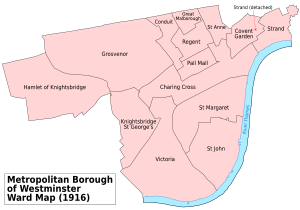Westminster Abbey (UK Parliament constituency) facts for kids
Quick facts for kids {{{Name}}}[[{{{Type}}} constituency]] |
|
|---|---|
| [[Image:{{{Map1}}}Constituency.svg|120px|]] [[Image:England{{{Map2}}}.svg|120px|]] |
|
| {{{Name}}} shown within [[{{{Entity}}}]], and {{{Entity}}} shown within England | |
| Created: | {{{Year}}} |
| MP: | {{{MP}}} |
| Party: | {{{Party}}} |
| Type: | House of Commons |
| County: | [[{{{County}}}]] |
| EP constituency: | [[{{{EP}}} (European Parliament constituency)|{{{EP}}}]] |
The Westminster Abbey area was a special part of the United Kingdom that elected one person to represent its people in the UK Parliament. This elected person is called a Member of Parliament (MP). They would sit in the House of Commons, which is where new laws are discussed and made. The MP was chosen using a system called "first past the post," meaning the candidate with the most votes won.
This special area was created for the 1918 general election. It included most of the old Westminster area and all of the old Strand area. It existed until the 1950 general election. After that, it joined with another area called the City of London to form a new area: Cities of London and Westminster.
People sometimes called this area the Abbey Division of Westminster or just Abbey. The Conservative Party always won the elections here during its entire existence.
Contents
Where was Westminster Abbey?
The City of Westminster is a well-known part of Inner London. Its southern edge is along the north side of the River Thames. In 1918, it was located west of the City of London. It was also south of Holborn and St. Pancras, and east of Kensington and Chelsea. The area included several wards (smaller districts) within the eastern part of the Metropolitan Borough of Westminster. These wards were Covent Garden, Great Marlborough, Pall Mall, Regent, St. Anne, St. John, St. Margaret, Strand, and part of Charing Cross.
A Look at Westminster Abbey's History
The Westminster Abbey area was created in 1918. It combined parts of the older Westminster and Strand areas. From 1918 to 1950, the area always elected MPs from the Conservative Party. Other parties like the Labour Party and the Liberal Party did not have much support here.
The 1921 By-election: Anti-Waste Movement
After the first MP, William Burdett-Coutts, passed away in 1921, a special election called a by-election was held. In this election, all three candidates said they were "anti-waste." This was because the Anti-Waste League was very active at the time. This group was started by a newspaper owner, Lord Rothermere. They wanted the government to spend less money and help the country recover financially.
The Conservative candidate, John Nicholson, won this by-election. However, the Anti-Waste League's candidate did quite well, and the Liberal candidate came in third.
The 1924 By-election: Winston Churchill's Challenge
When John Nicholson died in 1924, another by-election took place. The new Conservative candidate was Otho Nicholson. He faced a tough challenge from Winston Churchill, who was a very famous politician. Churchill ran as a "Constitutionalist." Another strong candidate was Fenner Brockway from the Labour Party, who later became an MP. There was also a less known Liberal candidate.
The term "Constitutionalist" was used by some candidates in the 1920s, often former Liberals like Churchill. They didn't act as a single party. Most of them eventually joined either the Liberal or Conservative Parties. Otho Nicholson won the election, beating Winston Churchill by a very small number of votes, only 43!
Changes by 1945
By the time of the 1945 general election, the number of voters in the area had almost halved compared to before World War II. The Labour Party's vote share was similar to what Fenner Brockway received in 1924. A candidate who had run as an "Independent Progressive" in 1939 now ran as a Communist and received a good number of votes. However, the Conservative Party still won with more than half of all the votes. For the 1950 general election, the Westminster Abbey area became a key part of the new Cities of London and Westminster constituency.
Members of Parliament for Westminster Abbey
This table shows the people who were elected as MPs for Westminster Abbey:
| Election | Member | Party | |
|---|---|---|---|
| 1918 | William Burdett-Coutts | Conservative | |
| 1921 by-election | John Nicholson | Conservative | |
| 1924 by-election | Otho Nicholson | Conservative | |
| 1932 by-election | Sir Sidney Herbert | Conservative | |
| 1939 by-election | Harold Webbe | Conservative | |



